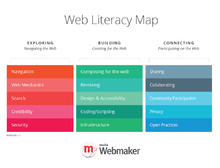Web literacy
Web literacy comprises the skills and competencies needed for reading, writing and participating on the web.[1] It has been described as "both content and activity" – i.e., web users should not just learn about the web but also how to make their own website.[2]
History of the concept
In the latter part of the 1990s, literacy researchers started to explore the differences between printed text and the network-enabled devices with screens. This research was largely focused on two areas: the credibility of information that can be found on the World Wide Web[3] and the difference that hypertext makes to 'reading' and 'writing'.[4] These skills were included in definitions of information literacy and included in a SCONUL position paper in 1999.[5] This paper became the '7 Pillars of Information Literacy', which was last updated in 2011.[6]
Web Literacy Map

The Mozilla Foundation is a non-profit organization that promotes openness, innovation and participation on the Internet. It has created a Web Literacy Map[1] in consultation with a community of stakeholders from formal and informal education, as well as industry.[7] Web literacy is described as "the skills and competencies needed for reading, writing and participating on the web".[1] Work on what was originally entitled a Web Literacy 'Standard' began in early 2013. Version 1.0 was launched at the Mozilla Festival later that year.[8] Going forward, 'standard' was seen to be problematic and against the ethos of what the Mozilla community was trying to achieve.[9]
Literacy Version 1.1 of the Web Literacy Map was released in early 2014[10] and underpins the Mozilla Foundation's Webmaker resources section, where learners and mentors can find activities that help teach related areas. Although the Web Literacy Map is a list of strands, skills and competencies, it is most commonly represented as a competency grid.
The Mozilla community finalised the version 1.5 of the Web Literacy Map at the end of March 2015.[11] This involves small changes to the competencies layer and a comprehensive review of the skills they contain.[12]
Exploring
(Navigating the Web)
- Navigation (Using software tools to browse the web)
- Web Mechanics (Understanding the web ecosystem)
- Search (Locating information, people and resources via the web)
- Credibility (Critically evaluating information found on the web)
- Security (Keeping systems, identities, and content safe)
Building
(Creating for the Web)
- Composing for the Web (Creating and curating content)
- Remixing (Modifying existing web resources to create something new)
- Design & Accessibility (Creating universally effective communications through web resources)
- Coding/Scripting (Creating interactive experiences on the web)
- Infrastructure (Understanding the Internet stack)
Connecting
(Participating on the Web)
- Sharing (Creating web resources with others)
- Collaborating (Providing access to web resources)
- Community Participation (Getting involved in web communities and understanding their practices)
- Privacy (Examining the consequences of sharing data online)
- Open Practices (Helping to keep the web democratic and universally accessible)
References
- Mozilla Web Literacy Map v1.1.0
- Davidson, C.N. & Surman, M. "Why Web Literacy Should Be Part of Every Education", Fast Company. Retrieved 2 February 2015.
- Detweiler, M. C., Hess, S. M., & Peck, A. C. (1996, October). Acquiring User-Centered Design Skills by Designing and Evaluating World Wide Web Pages. In Proceedings of the Human Factors and Ergonomics Society Annual Meeting (Vol. 40, No. 8, pp. 459-462). SAGE Publications
- Snyder, I., & Joyce, M. (Eds.). (1998). Page to screen: Taking literacy into the electronic era. Psychology Press.
- SCONUL Advisory Committee on Information Literacy (1999) Information skills in higher education: a SCONUL position paper. Prepared by the Information Skills Task Force, on behalf of SCONUL.
- SCONUL. (2011). 7 Pillars of Information Literacy Core Model. Retrieved 12 February 2015.
- Belshaw, D.A.J. & Smith, K.L. "Why Mozilla cares about Web Literacy". Retrieved 2 February 2015.
- Web Literacy Standard 1.0 from Mozilla. BoingBoing. Retrieved 12 February 2015.
- The Web Literacy Standard is dead (long live the Web Literacy Map!). Doug Belshaw's blog. Retrieved 12 February 2015.
- Why the Web Literacy Map will remain at v1.1 until MozFest. Mozilla Webmaker blog. Retrieved 12 February 2015.
- Building version 1.5 of Mozilla’s Web Literacy Map. Mozilla Webmaker blog. Retrieved 12 February 2015.
- Help us redefine the skills underpinning three Web Literacy Map competencies!. Literaci.es. Retrieved 12 February 2015.